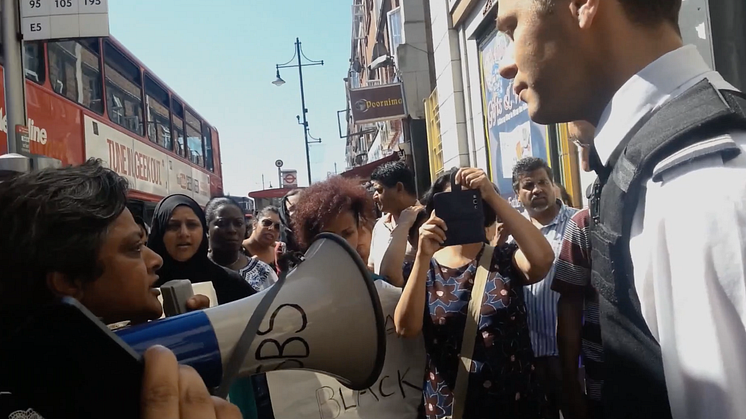Press release -
EXPERT COMMENT: Rogue One: a new front in long battle over the Star Wars brand
Andrew Ross, Graduate Tutor and Lecturer in Film at Northumbria University, writes about the release of highly anticipated Rogue One: A Star Wars Story.
It was hoped that the release of Rogue One, the current offshoot from the Star Wars series, would cement the Star Wars franchise as being at the cutting edge of modern cinema. Promising a markedly different tone from the previous films, the production has sparked debate over how far the content of Star Wars can be pushed while still maintaining its core values.
Conflicts over the nature of the Star Wars brand date back to 1978, when a bizarre US television variety show was screened set in the same universe. Featuring Imperial Stormtroopers listening to Jefferson Starship and original cast members juggling high adventure with comedy skits, the Star Wars Holiday Special was a catastrophic collision of tones.
So much so that, dismayed by the negative audience reaction, George Lucas instigated a policy of quality control eventually christened the “Holocron”. An all-encompassing database delineating what actually constitutes “Star Wars”, the series canon was an attempt by Lucas to negotiate the many spin offs which were contradicting the filmmaker’s own grand plan for his still developing saga.
Media theorists Henry Jenkins and Jonathan Gray cite Star Wars as an example of “spreadable media” – the series lending itself well to formats extending beyond the initial work, such as animated series or videogames. A great property to have, but the resultant “constellation of content” can be prone to instability if the centre of gravity is not fixed.
For example, the first Star Wars sequel novel, Splinter of the Mind’s Eye, suggested a developing romance between Luke and Leia. And the 1979 Star Wars Annual featured Obi Wan, Darth Vader and Anakin Skywalker crash landing on a planet together. This created a melange of competing narratives so disordered that Starburst magazine, with great foresight, commented:
It would be a sin for Star Wars to lose its credulity because no-one cared that say Darth Vader was proven to be Luke’s father on film but when unmasked in a novel he is found to be a complete stranger.
Learning from Marvel
In 2012, following the general fan derision afforded Lucas’s own prequel trilogy, brand credulity became a priority for new Star Wars producer Kathleen Kennedy when planning the latest phase of the franchise.
New owner Disney had, with another brand – Marvel – successfully transitioned popular comic book properties from page to screen by placing the superhero characters within contexts from a variety of different genres. The Western trappings of Guardians of the Galaxy, the fish out of water aspects of Thor and the political thriller beats of Captain America: the Winter Soldier all delivered the same zippy comic teamwork and fantastical exploits which made Marvel’s name as a publisher, but within constantly changing cinematic frameworks. This allowed the audience’s experience to remain fresh.
Creating a release pattern in which a main series episode such as The Force Awakensalternated with an “anthology” work, the new approach to Star Wars mirrors the Marvel method by creating multiple timelines and genres simultaneously across the franchise.
Going rogue
Rogue One – detailing the rebels’ attempts to steal the Death Star plans – appeared at first to correlate with this pattern. Rogue One was pitched by Godzilla director Gareth Edwards as a war film set within the Star Wars universe, and inspired by Gillo Pontecorvo’s coruscating 1966 documentary style The Battle of Algiers. The idea was for the series to explore a more serious theme and engage with the wider franchise in a sophisticated manner.
It has been reported that Disney’s top brass became troubled by the notion of this darker Star Wars. Although it is hard to ascertain at this stage how accurate the reports are (some suggest 40% of the film’s content was re-shot at the eleventh hour by a different director) the controversy suggests a sea change in how Lucasfilm sees the anthology films. No longer opportunities for experimentation and world building, the works now seem to be zero risk brand ambassadors.
To a certain extent this should come as no surprise. A mainstream franchise entry needs to be tailored for disparate tastes, carrying the PG13/12A certificate and appealing to small children as well as adults. But curtailing innovation is also a dangerous move. The Star Wars franchise should also be attempting to prevent box office fatigue by embracing diverse directorial viewpoints and original storylines. Otherwise, Star Wars may face the brand implosion currently threatening the Warner Bros. franchise of DC comic book characters.
Due to the large financial risk involved in producing a one-off theatrical release, within the next ten to 15 years all large scale mainstream films may be part of an extended constellation of content. And as demonstrated by the estate of John Le Carré, this is not limited to solely blockbuster fare. Recent adaptations of The Night Manager, Tinker Tailor Soldier Spy and Our Kind of Traitor all portray the same vision of Le Carré’s “circus” across multiple media.
We are at a unique point in the history of cinema, one which challenges the notion of what actually constitutes a “film”. Although early reviews have been positive if, on December 15, Lucasfilm does not hold true to the initial promise of Rogue One – to devise a new approach to Star Wars – the company could soon find its work as outmoded as the Star Wars Holiday Special.
This article was originally published in The Conversation. Read the original article.
Topics
Categories
Northumbria is a research-rich, business-focused, professional university with a global reputation for academic excellence. To find out more about our courses go to www.northumbria.ac.uk
If you have a media enquiry please contact our Media and Communications team at media.communications@northumbria.ac.uk or call 0191 227 4571.












